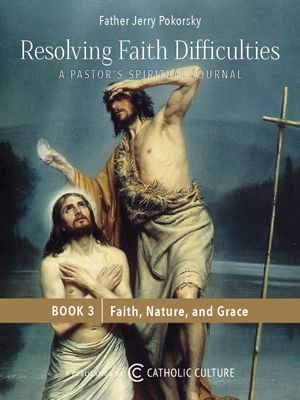Make your gift today!
Help keep Catholics around the world educated and informed.
Already donated? Log in to stop seeing these donation pop-ups.
Facing East
As the lightning comes from the East . . so shall the Son of Man appear" Mt 24:27). There it is, the scriptural basis for the Christian belief that when Jesus comes again in glory, He will come from the East. This belief is in turn the foundation for the ancient Christian practice of facing East while praying. In fact, already in the fourth century, St. Basil wrote that an eastern orientation in prayer was one of the most ancient traditions of the Church.
This eastern orientation carries several different meanings. Most basically, the East represents Christ. So strong is the identification of Christ with the East that sometimes He is simply called by that name. This is a continuation of an Old Testament theme that says of God, "The Orient is his name" (Zec 6:12). In our liturgy, we also name Jesus the "Orient, splendor of eternal light and sun of justice." So when we pray facing the East, we mean to face Christ himself.
The East also represents heaven in various ways. First, it is the place from which Christ will return. Facing the East therefore embodies a longing for Christ's Second Coming and an expression of eschatological hope.
At Mass, for example, after the Our Father, there is a prayer that begins, "Deliver us, Lord, from every evil." In the reformed liturgy of Vatican II, this prayer has been extended to include the phrase "as we wait in joyful hope for the coming of our Savior, Jesus Christ." In this way, our waiting and longing for Christ's coming is given a new emphasis.
Heaven is also the place where Christ lives in glory. In the literary account of her martyrdom, St. Perpetua is said to have seen four angels who, at the moment of her death, would carry her to the East, where she would meet Christ and live with Him forever.
Finally, heaven is also the eternal home that we desire. Facing the East was therefore thought to be a way of peering into Paradise, which God had "planted in the East" (Gn 2:8). St. Basil tells us:
It is by reason of an unwritten tradition that we turn to the East to pray. But little do we know that we are thus seeking the ancient homeland, the Paradise that God planted in Eden toward the East.
In all these ways, heaven expresses a human desire to go beyond the bounds of this life — in other words, a desire for transcendence.
An eastern orientation in prayer has been a salient characteristic of Catholic liturgical spirituality from the earliest centuries. Where a literal eastern orientation was not architecturally possible, as in the adaptation of the ancient Roman basilicas, the faithful simply turned in that direction. And, of course, when it was possible to orient a church eastward, as with the great medieval cathedrals, this was done. Then the eschatological and transcendent meanings of this orientation were further emphasized by apsidal art that depicted images of Christ and the saints in heavenly glory.
Eastern orientation in liturgical prayer is so ancient, and it has been so persistent through the centuries, that we must question the relative neglect of it in our time. The current manner of celebrating Mass, for example, has heightened our awareness of the immanent dimensions of the Eucharist. While this is valuable in itself, we cannot let the equally important eschatological and transcendent dimensions be too drastically diminished. Especially in troubled times, shouldn't our liturgical prayer be oriented toward heaven and hope in an evident way?
Yet, since God has planted a desire for heaven in human hearts, its liturgical expression cannot long be ignored. Now, as we prepare to enter a new era of Christian history, perhaps the time is right for us to take another look at the ancient practice of facing the East in prayer.
Father Carey, a Dominican priest of the Western Province, is the director of the Sante Fe Institute in Berkeley, Calif. He is also the director of Clergy Education and a member of the Archdiocesan Liturgical Commission for the Archdiocese of San Francisco.
© The Priest, Our Sunday Visitor Publishing, 200 Noll Plaza, Huntington, In 46750.
This item 1353 digitally provided courtesy of CatholicCulture.org






